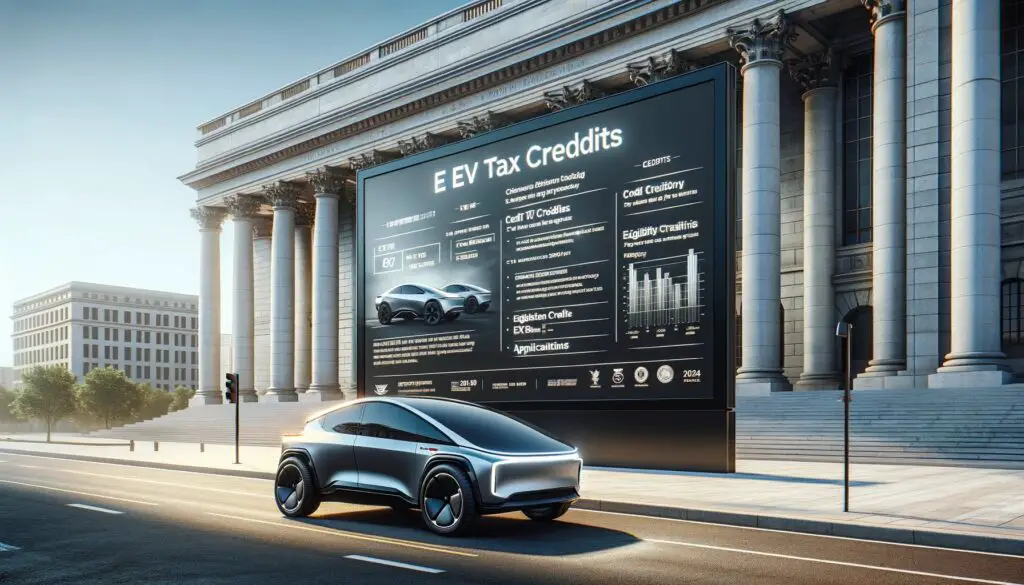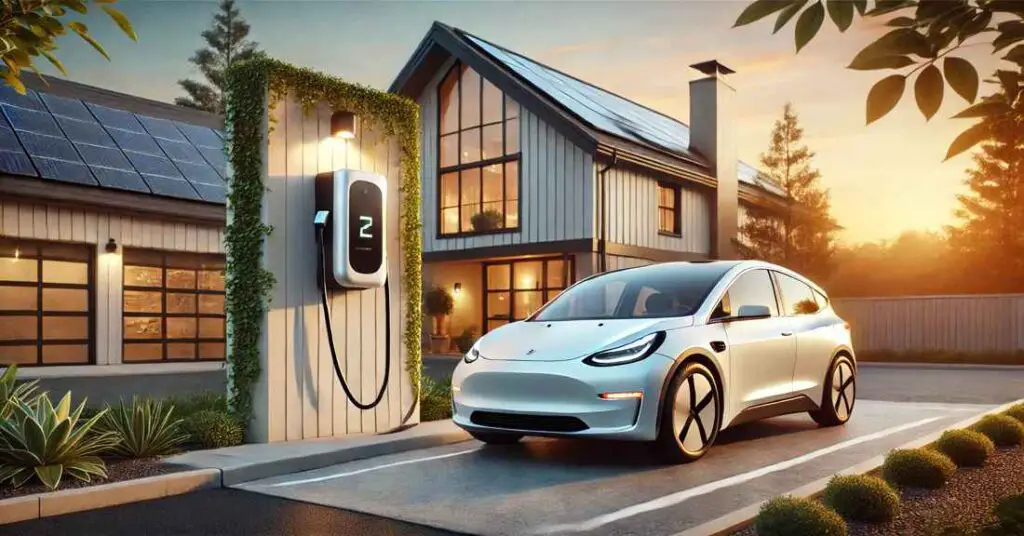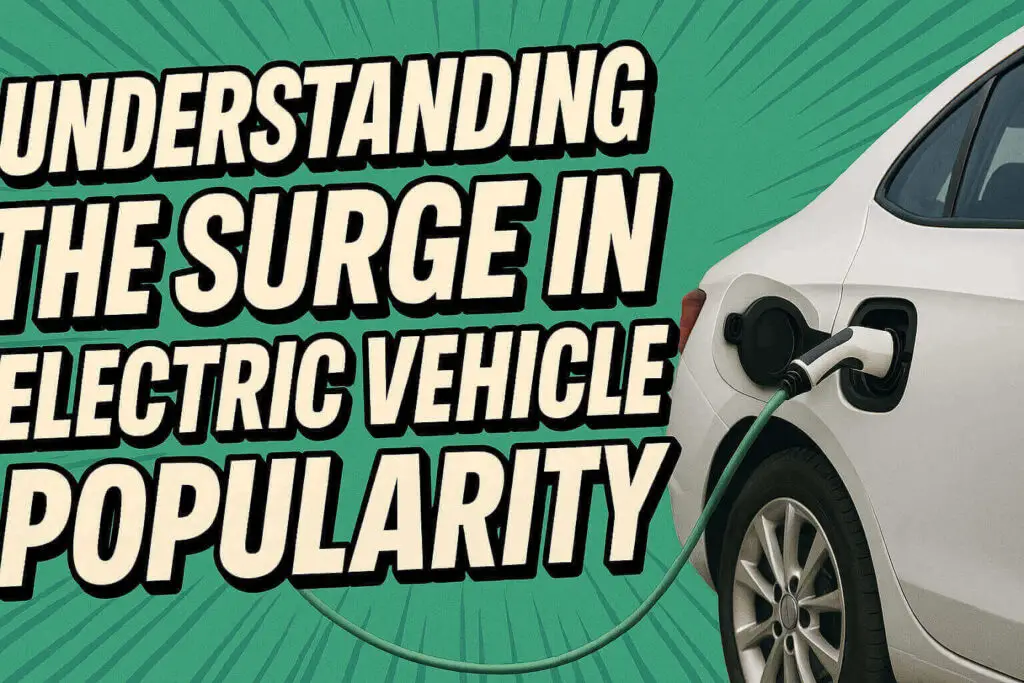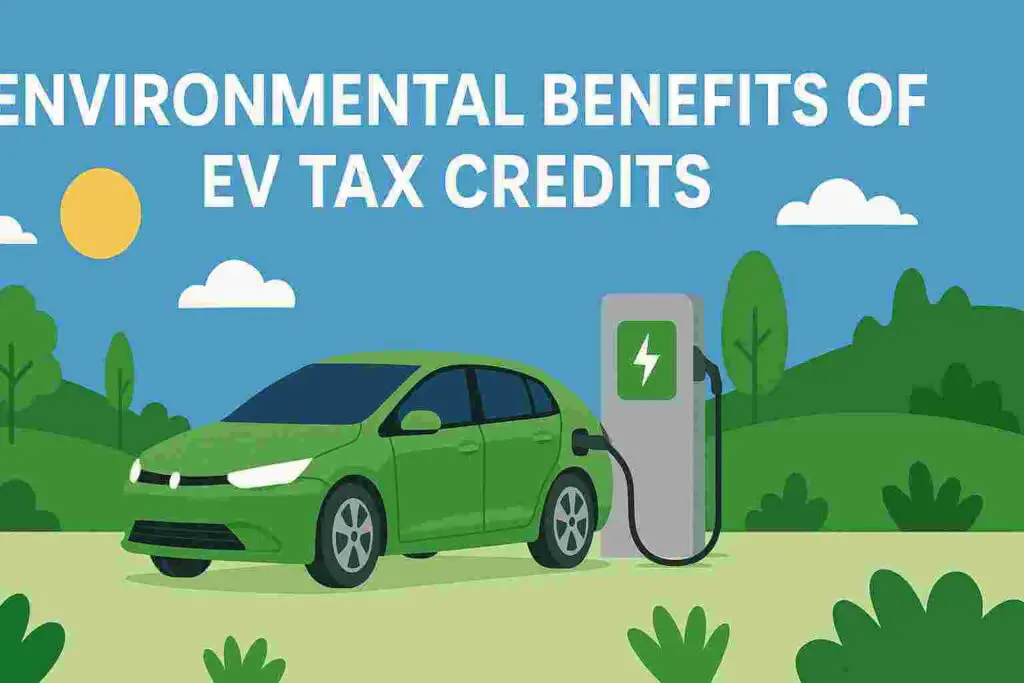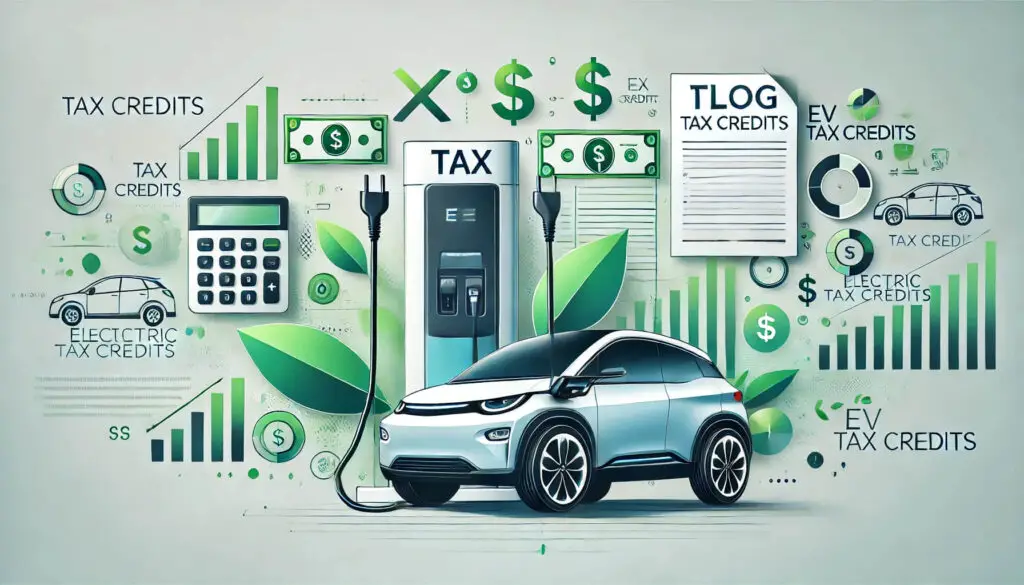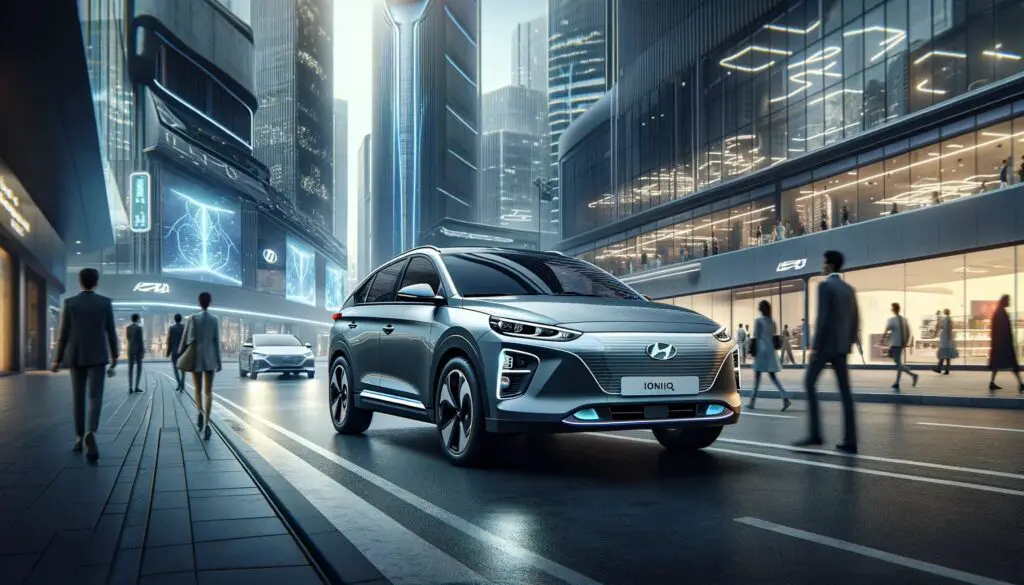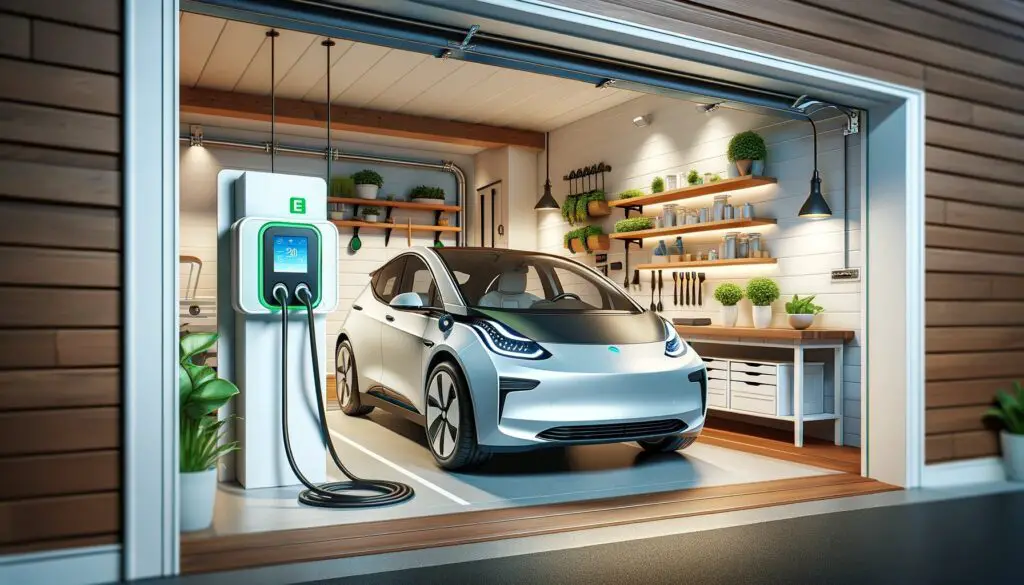In 2024, Electric Vehicle (EV) tax credits play a pivotal role in fostering sustainable transportation practices. This guide delves into the intricacies of EV tax credits, elucidating their significance and providing insights into claiming and maximizing these benefits.
Understanding EV Tax Credits
Electric Vehicle (EV) tax credits are government incentives designed to accelerate the adoption of environmentally friendly vehicles. These credits play a vital role in promoting sustainability and mitigating the adverse effects of traditional combustion engine vehicles on the environment. In this section, we will delve deeper into the intricacies of EV tax credits, exploring their significance, mechanisms, and environmental benefits.
Significance of EV Tax Credits
- Promoting Sustainability: EV tax credits encourage consumers to choose electric vehicles over conventional gasoline-powered cars, thereby reducing greenhouse gas emissions and dependence on fossil fuels.
- Fostering Technological Innovation: By stimulating demand for electric vehicles, tax credits incentivize manufacturers to invest in research and development of advanced EV technologies, leading to the production of more efficient and affordable electric vehicles.
- Boosting Economic Growth: The adoption of electric vehicles creates opportunities for job growth and innovation in the clean energy sector, contributing to economic development and competitiveness in the global market.
Mechanisms of EV Tax Credits
- Financial Incentives: EV tax credits provide financial incentives to consumers and businesses, reducing the upfront cost of purchasing electric vehicles and making them more accessible to a wider audience.
- Tax Deductions vs. Tax Credits: Unlike tax deductions, which reduce taxable income, tax credits directly offset tax liability, resulting in greater savings for eligible taxpayers.
- Government Support: EV tax credits are typically administered by government agencies at the federal or state level, with eligibility criteria and credit amounts varying depending on jurisdiction and legislative policies.
Environmental Benefits of EV Tax Credits
- Reduced Emissions: Electric vehicles produce lower emissions compared to internal combustion engine vehicles, resulting in improved air quality and reduced environmental pollution.
- Conservation of Natural Resources: By reducing the consumption of fossil fuels, electric vehicles help conserve natural resources and mitigate the negative impacts of extraction and combustion on ecosystems and biodiversity.
- Climate Change Mitigation: The widespread adoption of electric vehicles facilitated by tax incentives contributes to global efforts to combat climate change by reducing greenhouse gas emissions and mitigating the effects of global warming.
New Clean Vehicle Credit
The New Clean Vehicle Credit is a valuable financial incentive aimed at encouraging the adoption of electric vehicles (EVs) by both individual consumers and businesses. This credit rewards eligible applicants with tax credits based on the battery capacity of the purchased vehicle, providing greater incentives for vehicles equipped with larger batteries.
Key Features
- Variable Credit Amount: The amount of credit available under the New Clean Vehicle Credit varies depending on the size of the vehicle’s battery. Generally, vehicles with larger battery capacities qualify for higher tax credits, reflecting the increased environmental benefits associated with longer driving ranges and reduced emissions.
- Inclusive Eligibility Criteria: The eligibility criteria for the New Clean Vehicle Credit extend to both individual consumers and businesses, ensuring that a diverse range of stakeholders can benefit from the financial incentives provided.
- Claim Process: Claiming the New Clean Vehicle Credit entails filing a federal income tax return using Form 8936. This form allows applicants to report their eligible EV purchases and calculate the corresponding tax credits to be applied towards their tax liabilities.
Credit Transfer to Dealers
In 2024, a notable enhancement to the New Clean Vehicle Credit is the option for credit transfer to dealerships. This innovative mechanism simplifies the purchasing process for EV buyers by enabling them to transfer their tax credits directly to the dealership at the point of sale.
By facilitating credit transfers, this option streamlines the transaction process, reducing administrative burdens and paperwork for both buyers and sellers. Additionally, buyers can immediately benefit from the tax credit at the time of purchase, effectively reducing the upfront cost of acquiring an electric vehicle.
Overall, the introduction of credit transfer to dealerships enhances accessibility and convenience for consumers interested in transitioning to electric vehicles. This streamlined approach aligns with broader efforts to promote EV adoption and accelerate the transition towards sustainable transportation solutions.
Used Clean Vehicle Credit
The Used Clean Vehicle Credit is a commendable initiative that extends incentives to individuals purchasing pre-owned electric vehicles (EVs). By incentivizing the circulation of sustainable transportation options, this credit promotes the adoption of environmentally friendly vehicles and contributes to efforts aimed at reducing carbon emissions and mitigating climate change.
Credit Amount and Percentage
- Determinants: The credit amount and percentage offered under the Used Clean Vehicle Credit are determined based on two primary factors: the vehicle’s battery capacity and its year of manufacture. Vehicles equipped with larger battery capacities and manufactured in recent years typically qualify for higher tax credits, reflecting their superior environmental performance and technological advancements.
- Variable Incentives: The credit amount and percentage may vary depending on the specific attributes of the vehicle, with newer models and those featuring advanced battery technologies often eligible for more substantial incentives. This variability ensures that tax credits are aligned with the environmental benefits and energy efficiency of individual EVs.
Eligibility Criteria
- Stringent Requirements: The Used Clean Vehicle Credit imposes specific eligibility criteria to ensure that only qualifying vehicles receive tax incentives. These criteria may encompass factors such as the vehicle’s age, mileage, condition, and compliance with emission standards.
- Environmental Compliance: Eligible vehicles must meet stringent environmental standards and emission regulations to qualify for the credit. This requirement underscores the importance of prioritizing vehicles that adhere to sustainability principles and contribute to overall environmental conservation efforts.
- Verification Process: Applicants seeking to claim the Used Clean Vehicle Credit must undergo a thorough verification process to confirm the eligibility of the purchased vehicle. This process may involve submitting documentation, such as vehicle registration records, maintenance history, and emission test results, to demonstrate compliance with the credit’s requirements.
Encouraging Sustainable Choices
By offering financial incentives for the purchase of pre-owned electric vehicles, the Used Clean Vehicle Credit encourages consumers to make sustainable transportation choices while also promoting the circulation of existing EV inventory. This initiative not only reduces the environmental impact of vehicle ownership but also facilitates the transition towards a more sustainable and low-carbon transportation infrastructure.
Eligibility Requirements for EV Tax Credits
Distinguishing between eligibility criteria for new and used EV tax credits is essential for prospective buyers seeking to leverage these incentives. Understanding the specific requirements ensures that individuals and businesses can maximize their eligibility and claim the appropriate amount of credit to offset their tax liabilities effectively. In this section, we will explore the key eligibility requirements for both new and used EV tax credits, highlighting the factors that influence eligibility and credit amounts.
New EV Tax Credits
- Income Limits: Eligibility for new EV tax credits may be subject to income limits imposed by federal or state authorities. These limits vary depending on factors such as filing status, household size, and geographical location, and may change annually.
- Vehicle Specifications: To qualify for new EV tax credits, vehicles must meet certain specifications, including battery capacity, vehicle weight, and emission standards. Manufacturers typically provide detailed information on eligible models and their corresponding tax credits.
- Purchase Timelines: The timing of the vehicle purchase is critical for claiming new EV tax credits. Buyers must ensure that their purchase falls within the designated timeframe specified by relevant tax authorities to qualify for the credit.
Used EV Tax Credits
- Condition of the Vehicle: Used EV tax credits may be contingent upon the condition of the vehicle at the time of purchase. Vehicles must meet minimum standards of roadworthiness and safety to qualify for the credit.
- Vehicle History: Buyers must verify the vehicle’s history, including its mileage, maintenance records, and previous ownership, to ensure compliance with eligibility requirements. Vehicles with a documented history of regular maintenance and proper care are more likely to qualify for the credit.
- Emission Standards: Used EVs seeking tax credits must comply with applicable emission standards and environmental regulations. Buyers should confirm that the vehicle meets or exceeds these standards to qualify for the credit.
Maximizing Eligibility and Claiming Credits
To maximize eligibility for EV tax credits and claim the appropriate amount of credit, prospective buyers should:
- Research: Conduct thorough research to understand the eligibility criteria and requirements for both new and used EV tax credits.
- Consult Professionals: Seek guidance from tax professionals or financial advisors specializing in EV tax incentives to ensure compliance with relevant regulations and optimize tax savings.
- Maintain Documentation: Keep detailed records of the vehicle purchase, including purchase contracts, registration documents, and proof of compliance with eligibility criteria, to facilitate the claiming process.
By adhering to these guidelines and fulfilling the necessary requirements, individuals and businesses can effectively leverage EV tax credits to offset the cost of purchasing electric vehicles and contribute to the transition towards sustainable transportation solutions.
Claiming Your EV Tax Credit
Navigating the process of claiming EV tax credits requires careful attention to detail and adherence to specific guidelines. Here’s a step-by-step guide to help individuals and businesses seamlessly submit their claims and maximize their benefits:
1. Gather Necessary Documentation
Before initiating the claim process, gather all relevant documentation related to the purchase of the electric vehicle. This includes:
- Purchase Receipts: Obtain copies of purchase receipts or invoices confirming the acquisition of the electric vehicle.
- Form 8936: Secure a copy of IRS Form 8936, which is used to claim the Qualified Plug-in Electric Drive Motor Vehicle Credit.
- Vehicle Information: Collect detailed information about the electric vehicle, including its make, model, year of manufacture, and Vehicle Identification Number (VIN).
2. Complete Relevant Sections of the Federal Income Tax Return
Next, complete the relevant sections of your federal income tax return to claim the EV tax credit. This typically involves:
- Form 1040: If you are an individual taxpayer, report the EV tax credit on your Form 1040, specifically on the appropriate line for tax credits.
- Form 1040-C: For businesses, report the EV tax credit on the appropriate line of your business tax return, such as Form 1040-C for corporations or Form 1040-SS for self-employed individuals.
3. Submit the Claim Within Stipulated Deadlines
Ensure that you submit your EV tax credit claim within the stipulated deadlines to maximize your benefits. Failure to file within the designated timeframe may result in forfeiture of the credit.
- Tax Year Deadline: The deadline for claiming EV tax credits typically corresponds to the tax year in which the electric vehicle was purchased. Check the IRS website or consult with a tax professional to determine the specific deadline for your claim.
- Filing Extensions: If necessary, request a filing extension from the IRS to ensure adequate time for claim submission. Be mindful of any additional requirements or documentation needed to support your extension request.
By following these steps and meticulously adhering to the claim submission process, individuals and businesses can successfully claim their EV tax credits and reap the financial benefits of transitioning to electric vehicles. Remember to retain copies of all documentation for your records and consult with a tax professional if you encounter any challenges or require further assistance during the claiming process.
Impact of Battery Sourcing and Manufacturing Location on EV Tax Credits
The sourcing and manufacturing locations of electric vehicle (EV) batteries play a crucial role in determining eligibility for tax credits. Buyers must carefully consider these factors to ensure compliance with credit requirements and regulations. In this section, we will explore the implications of battery sourcing and manufacturing location on EV tax credits.
1. Sourcing Location
The sourcing location refers to the origin of the materials used in the production of EV batteries. Factors to consider include:
- Domestic Sourcing: EV batteries sourced from domestic suppliers may qualify for additional tax incentives or preferential treatment under government incentive programs aimed at promoting domestic manufacturing and job creation.
- International Sourcing: Batteries sourced from international suppliers may still be eligible for tax credits, but buyers must ensure compliance with regulations governing importation and trade agreements to qualify for incentives.
2. Manufacturing Location
The manufacturing location refers to the geographical location where EV batteries are produced. Considerations include:
- Domestic Manufacturing: EV batteries manufactured domestically may qualify for tax credits or incentives aimed at promoting domestic manufacturing and economic growth. Buyers should verify the manufacturing location to determine eligibility for applicable incentives.
- International Manufacturing: Batteries manufactured internationally may still be eligible for tax credits, but buyers must ensure compliance with regulations governing international trade and manufacturing standards to qualify for incentives.
3. Compliance Requirements
Buyers must ensure compliance with credit requirements and regulations related to battery sourcing and manufacturing location. Key considerations include:
- Documentation: Maintain detailed records documenting the sourcing and manufacturing locations of EV batteries, including supplier information, manufacturing facilities, and certification documents, to support eligibility claims.
- Regulatory Compliance: Stay informed about regulatory requirements governing battery sourcing and manufacturing location to ensure compliance with applicable laws and regulations. Failure to meet compliance requirements may result in disqualification from tax credits and incentives.
Understanding the Non-Refundable Nature of Used EV Credits
The non-refundable nature of used electric vehicle (EV) credits underscores the importance of strategic planning to optimize benefits. Buyers must carefully consider this characteristic and explore avenues to maximize savings while minimizing financial implications. In this section, we will delve into the implications of the non-refundable nature of used EV credits and strategies for maximizing benefits.
1. Non-Refundable Nature
Used EV credits, once claimed, cannot be refunded or carried forward to future tax years. This means that buyers must carefully assess their eligibility and claim the credit only when they can fully utilize it to offset their tax liabilities.
2. Strategic Planning
To optimize benefits from non-refundable used EV credits, buyers should consider the following strategies:
- Timing: Timing the claim of the credit to align with higher tax liabilities can maximize the value of the credit and reduce overall tax burdens.
- Tax Planning: Engage in proactive tax planning to identify opportunities for maximizing the utilization of the credit within the current tax year.
- Documentation: Maintain accurate records and documentation related to the purchase of the used electric vehicle to support the claim of the credit and minimize the risk of audits or disputes with tax authorities.
3. Maximizing Savings
While used EV credits are non-refundable, buyers can still maximize their savings by:
- Exploring Other Incentives: Supplementing the non-refundable credit with other tax incentives or rebates available at the federal, state, or local levels to further reduce the overall cost of EV ownership.
- Negotiating Purchase Price: Negotiating the purchase price of the used electric vehicle to offset any potential financial implications associated with the non-refundable nature of the credit.
Navigating the Dealership Credit Transfer Option
Transferring tax credits to dealerships offers convenience but requires careful consideration. Prospective buyers should weigh the advantages and drawbacks to make informed decisions. In this section, we will explore the dealership credit transfer option, highlighting its benefits, drawbacks, and considerations for buyers.
1. Advantages
- Streamlined Process: Transferring tax credits to dealerships streamlines the purchasing process, allowing buyers to immediately benefit from the credit at the point of sale.
- Reduced Upfront Costs: By applying the tax credit towards the purchase price of the electric vehicle, buyers can reduce their upfront costs and potentially afford a higher-priced model or additional features.
- Simplified Paperwork: Dealerships often handle the paperwork associated with transferring tax credits, reducing administrative burdens and ensuring compliance with regulatory requirements.
2. Drawbacks
- Potential for Lower Savings: Dealerships may offer lower prices or incentives in exchange for transferring tax credits, potentially reducing the overall savings for buyers.
- Limited Negotiation Power: Buyers may have limited negotiation power when transferring tax credits to dealerships, as dealers may dictate the terms and conditions of the transfer.
- Complexity of Transactions: Transferring tax credits to dealerships may involve complex financial transactions and contractual agreements, requiring careful review and understanding by both parties.
3. Considerations for Buyers
- Financial Impact: Evaluate the financial implications of transferring tax credits to dealerships, considering the potential reduction in savings and overall cost of EV ownership.
- Negotiation: Negotiate the terms of the credit transfer with the dealership to ensure a fair and beneficial arrangement for both parties.
- Documentation: Obtain and review all documentation related to the credit transfer, including contracts, agreements, and disclosures, to ensure transparency and compliance with regulatory requirements.
Income Limitations and Their Impact
Income limitations impose constraints on credit eligibility, necessitating strategic planning for potential buyers. Understanding these limitations is crucial for maximizing tax incentives. In this section, we will explore the impact of income limitations on tax credit eligibility and strategies for prospective buyers to navigate these constraints effectively.
1. Impact of Income Limitations
- Reduced Eligibility: Income limitations may restrict the eligibility of high-income individuals or households for certain tax credits, limiting their ability to claim incentives or reducing the amount of credit available.
- Strategic Planning: Prospective buyers must assess their income levels and plan strategically to optimize tax incentives while staying within the prescribed income thresholds.
- Equitable Distribution: Income limitations aim to promote equitable distribution of tax incentives by targeting assistance towards individuals and households with lower income levels who may face greater financial barriers to EV adoption.
2. Strategies for Navigating Income Limitations
- Maximize Deductions: Explore opportunities to maximize deductions and reduce taxable income, thereby potentially lowering income levels and increasing eligibility for tax credits.
- Spousal Income Consideration: Consider the combined income of spouses or household members when assessing eligibility for tax credits, as income thresholds may vary depending on filing status and household composition.
- Timing of Income: Strategically time income-related events, such as bonuses or retirement withdrawals, to optimize eligibility for tax credits and minimize the impact of income limitations.
3. Compliance and Documentation
- Ensure Compliance: Adhere to income limitations and eligibility criteria specified by tax authorities to avoid penalties or disqualification from tax credits.
- Maintain Documentation: Keep detailed records and documentation related to income levels, deductions, and tax filings to support eligibility claims and ensure compliance with regulatory requirements.
The Role of Licensed Dealers in the Used EV Credit
Purchases of used electric vehicles must be made through licensed dealerships to qualify for tax credits. Verifying dealer licenses ensures compliance with regulatory requirements. In this section, we will explore the importance of licensed dealerships in the context of used EV credits and the significance of verifying dealer licenses for prospective buyers.
1. Regulatory Compliance
- Mandatory Requirement: Tax credits for used electric vehicles are contingent upon purchases being made through licensed dealerships. This requirement is mandated by regulatory authorities to ensure transparency, accountability, and consumer protection in the automotive industry.
- Legal Obligation: Licensed dealerships are obligated to adhere to state and federal regulations governing vehicle sales and ensure compliance with laws related to vehicle registration, title transfer, and consumer rights.
2. Consumer Protection
- Quality Assurance: Purchasing from licensed dealerships provides consumers with assurance regarding the quality, authenticity, and legality of the transaction. Licensed dealerships are subject to oversight and regulation, reducing the risk of fraudulent or deceptive practices.
- Recourse Mechanisms: Consumers who encounter issues or disputes with their used EV purchases can seek recourse through regulatory agencies or legal channels, leveraging the protections afforded by licensing requirements.
3. Verifying Dealer Licenses
- Due Diligence: Prospective buyers should conduct due diligence to verify the licensing status of dealerships before making a purchase. This can be done by requesting proof of licensure or conducting online searches through state regulatory agencies or professional associations.
- Documentation Review: Reviewing dealership documentation, such as business licenses, permits, and certifications, can provide additional assurance of compliance with regulatory requirements and legitimacy of operations.
Frequently Asked Questions (FAQs)
Can I claim EV tax credits for a lease?
Yes, lessees may be eligible for tax credits, subject to certain conditions.
What happens if my EV doesn’t meet all the criteria?
Failure to meet eligibility criteria may result in the disqualification of tax credits.
How do I know if a specific model is eligible for the credit?
Refer to IRS guidelines or consult with a tax professional for guidance on eligible models.
Can I claim both types of credits in the same year?
Yes, eligible buyers can claim both new and used EV credits within the same tax year.
How does the tax credit affect the overall cost of owning an EV?
Tax credits substantially reduce the upfront cost of purchasing an EV, making ownership more financially feasible.
Case Studies: Maximizing EV Tax Credits
Case Study 1: John’s Strategic Timing
John, a prospective EV buyer, carefully planned his purchase to maximize tax credits. He researched IRS guidelines and discovered that tax credits are based on the timing of the purchase. Understanding this, John strategically waited until the beginning of the tax year to buy his electric vehicle. By doing so, he was able to claim the maximum tax credit available for that year, resulting in substantial savings on his tax bill.
Key Points:
- Research: John conducted thorough research on IRS guidelines regarding EV tax credits.
- Timing: He strategically timed his purchase at the beginning of the tax year to maximize the credit amount.
- Savings: John’s strategic timing resulted in significant savings on his tax bill.
Case Study 2: Emily’s Bundle Strategy
Emily, another EV buyer, utilized a bundle strategy to maximize her tax credits. She discovered that she could claim both the federal EV tax credit and state-level incentives simultaneously. Emily meticulously researched the available state incentives and found programs offering additional rebates or credits for EV purchases. By combining these incentives with the federal tax credit, Emily was able to substantially reduce the overall cost of her electric vehicle.
Key Points:
- Research: Emily extensively researched state-level incentives in addition to federal tax credits.
- Bundle Strategy: She strategically combined multiple incentives to maximize her savings.
- Cost Reduction: Emily’s bundle strategy significantly lowered the overall cost of her EV purchase.
Case Study 3: David’s Utilization of Employer Programs
David, an employee at a forward-thinking company, took advantage of employer programs to maximize his EV tax credits. He discovered that his employer offered incentives for employees who purchased electric vehicles. David researched the program requirements and found that he could qualify for additional incentives by purchasing an EV through the company’s preferred dealership. By participating in his employer’s program, David was able to access exclusive discounts and incentives, further enhancing his tax savings.
Key Points:
- Employer Programs: David leveraged his employer’s incentives for EV purchases.
- Exclusive Benefits: He accessed exclusive discounts and incentives through his employer’s program.
- Strategic Partnership: David’s collaboration with his employer’s preferred dealership maximized his tax savings.
Importance of Consulting with Tax Professionals for EV Tax Credits
Consulting with tax professionals who specialize in EV tax credits offers numerous benefits and ensures a smooth claiming process. Let’s delve deeper into why this is crucial:
- Expertise in EV Tax Credits: Tax professionals specializing in EV tax credits possess in-depth knowledge and understanding of the complex regulations and requirements associated with these incentives. Their expertise allows them to provide accurate guidance tailored to each individual’s or business’s specific circumstances.
- Tailored Advice: Tax professionals can offer personalized advice based on an individual’s financial situation, eligibility for various credits, and optimization strategies. They can assess factors such as income levels, filing status, and vehicle specifications to determine the most advantageous approach for claiming tax credits.
- Maximizing Savings: By working with tax professionals, individuals and businesses can maximize their savings by identifying all available tax credits and incentives. These professionals can help navigate the nuances of different credits, such as new vs. used EV credits, and ensure that taxpayers claim the full benefits they are entitled to.
- Navigating Complexities: The process of claiming EV tax credits can be complex, involving intricate documentation, filing requirements, and compliance with regulations. Tax professionals can guide taxpayers through these complexities, ensuring that all necessary forms are completed accurately and submitted on time to avoid potential penalties or delays.
- Facilitating the Claiming Process: Tax professionals can streamline the claiming process by assisting with the preparation of tax returns, verifying eligibility criteria, and compiling relevant documentation. Their expertise reduces the likelihood of errors or omissions that could impact the outcome of the claim.
- Staying Updated on Changes: Tax laws and regulations pertaining to EV tax credits may change over time, requiring careful monitoring and interpretation. Tax professionals stay abreast of these changes and provide updated guidance to their clients, ensuring compliance with current laws and maximizing available benefits.
Additional Incentives and Rebates
Exploring state, local, and utility incentives complements federal tax credits, further enhancing savings for EV buyers. Combining multiple incentives maximizes financial benefits and promotes sustainable transportation practices. Here’s why considering additional incentives and rebates is essential:
- Comprehensive Savings: State, local, and utility incentives offer additional opportunities for savings beyond federal tax credits. These incentives may include rebates, grants, discounts on vehicle purchases, and special financing options tailored to promote EV adoption.
- Regional Variations: Incentive programs vary by region, reflecting local priorities, environmental goals, and infrastructure development initiatives. By exploring available incentives in their area, EV buyers can capitalize on region-specific opportunities to maximize savings and support local sustainability efforts.
- Holistic Approach: Combining multiple incentives creates a holistic approach to cost reduction, addressing various financial barriers to EV ownership. By leveraging federal, state, local, and utility incentives together, buyers can significantly offset the upfront costs of purchasing an electric vehicle and make sustainable transportation more accessible to a broader range of consumers.
- Promotion of Sustainable Practices: Incentive programs incentivize the adoption of electric vehicles, contributing to reduced greenhouse gas emissions, improved air quality, and decreased reliance on fossil fuels. By offering financial incentives for EV purchases, governments and utilities promote sustainable transportation practices and support the transition to cleaner energy sources.
- Encouraging Market Growth: Robust incentive programs stimulate market demand for electric vehicles, spurring innovation, investment, and technological advancements in the EV industry. As adoption rates increase and economies of scale are achieved, EV prices may further decline, making electric vehicles more affordable and attractive to consumers.
- Community Engagement: Incentive programs often involve community outreach and education initiatives to raise awareness about the benefits of electric vehicles and encourage widespread adoption. By engaging with local stakeholders and incentivizing EV purchases, governments and utilities foster a sense of collective responsibility for environmental stewardship and sustainable development.
Environmental Impact of Switching to EVs
Transitioning to electric vehicles yields significant environmental benefits, including reduced carbon emissions and improved air quality. EV tax credits incentivize eco-friendly choices, contributing to a cleaner, greener future. Here’s why the environmental impact of switching to EVs is crucial:
- Reduced Carbon Emissions: Electric vehicles produce fewer greenhouse gas emissions compared to traditional internal combustion engine vehicles. By eliminating tailpipe emissions and relying on electricity generated from renewable sources, EVs help mitigate climate change and reduce the carbon footprint of transportation.
- Improvement in Air Quality: The adoption of electric vehicles leads to improved air quality in urban areas, where pollution from vehicle exhaust is a significant concern. By reducing emissions of harmful pollutants such as nitrogen oxides (NOx) and particulate matter (PM), EVs contribute to healthier and cleaner environments for communities and ecosystems.
- Resource Conservation: Electric vehicles are more energy-efficient than conventional vehicles, requiring less energy to operate and travel the same distance. Additionally, EVs have the potential to utilize energy storage systems and vehicle-to-grid (V2G) technology, enabling them to contribute to grid stability and energy resilience while maximizing the use of renewable energy resources.
- Mitigation of Environmental Impacts: The production and disposal of batteries used in electric vehicles may have environmental impacts, including resource extraction, energy consumption, and waste management. However, advancements in battery technology and recycling processes are continuously improving the environmental sustainability of EVs, making them increasingly viable as a low-impact transportation option.
- Long-Term Sustainability: Switching to electric vehicles aligns with long-term sustainability goals and environmental objectives outlined in international agreements such as the Paris Agreement. By transitioning away from fossil fuel-powered vehicles and embracing electric transportation solutions, societies can work towards a more resilient and sustainable future for generations to come.
- Role of EV Tax Credits: EV tax credits play a vital role in incentivizing consumers to choose electric vehicles over conventional gasoline-powered cars. By reducing the upfront cost of EVs and making them more financially accessible, tax credits encourage widespread adoption of eco-friendly transportation options and accelerate the transition towards a zero-emission transportation sector.
Conclusion
In conclusion, EV tax credits serve as powerful incentives for promoting sustainable transportation practices. By understanding eligibility criteria, claiming processes, and strategic planning strategies, buyers can unlock substantial savings and contribute to environmental conservation efforts.
Call to Action
Empowered with knowledge and resources, readers are encouraged to embark on their EV purchase journey. Start exploring eligible models and calculating potential savings to make informed decisions for a greener tomorrow.
Glossary of Terms
- EV Tax Credits: Financial incentives offered by governments to encourage the adoption of electric vehicles (EVs) by reducing the cost of purchasing or leasing an EV.
- Electric Vehicle (EV): A vehicle that operates using one or more electric motors powered by rechargeable batteries or other energy storage systems.
- Tax Credit: A dollar-for-dollar reduction in the amount of tax owed by an individual or business, typically offered as an incentive to promote specific behaviors or activities, such as purchasing electric vehicles.
- New Clean Vehicle Credit: A type of EV tax credit available for the purchase of new electric vehicles, offering financial incentives based on factors such as battery capacity and vehicle specifications.
- Used Clean Vehicle Credit: An EV tax credit applicable to the purchase of pre-owned electric vehicles, providing financial incentives to buyers of used EVs meeting specified criteria.
Resource List
- IRS Website: Official website of the Internal Revenue Service (IRS), providing comprehensive information and guidance on EV tax credits, forms, and filing procedures. (https://www.irs.gov/)
- NerdWallet: Online platform offering tools, articles, and resources for financial planning and decision-making, including information on EV tax credits and incentives. (https://www.nerdwallet.com/)
- Electric Auto Association (EAA): Non-profit organization dedicated to promoting the adoption of electric vehicles through education, advocacy, and community engagement. The EAA website offers resources, forums, and information for EV enthusiasts and buyers. (https://electricauto.org/)
- Plug In America: Non-profit organization advocating for the widespread adoption of plug-in electric vehicles (PEVs) to reduce greenhouse gas emissions and dependence on fossil fuels. The Plug In America website provides resources, news, and information on EVs and charging infrastructure. (https://pluginamerica.org/)
- Department of Energy (DOE) – Alternative Fuels Data Center: DOE’s Alternative Fuels Data Center offers resources and information on alternative fuels, including electric vehicles, EV charging infrastructure, and incentives available at the state and local levels. (https://afdc.energy.gov/)
- Clean Vehicle Rebate Project (CVRP): California-based initiative offering rebates for the purchase or lease of eligible zero-emission and plug-in hybrid vehicles. The CVRP website provides information on available rebates, eligibility criteria, and application procedures. (https://cleanvehiclerebate.org/)
- State Department of Motor Vehicles (DMV) Websites: State DMV websites often provide information on EV incentives, vehicle registration requirements, and forms related to electric vehicle ownership. Check your state’s DMV website for relevant resources and information.
- Local Utility Websites: Many local utility companies offer incentives and rebates for EV charging equipment installation, time-of-use electricity rates for EV owners, and other programs to support electric vehicle adoption. Visit your utility company’s website for information on available incentives and programs.
This comprehensive guide equips readers with the knowledge and tools necessary to navigate the intricacies of EV tax credits in 2024, facilitating informed decision-making and promoting the widespread adoption of sustainable transportation solutions.

